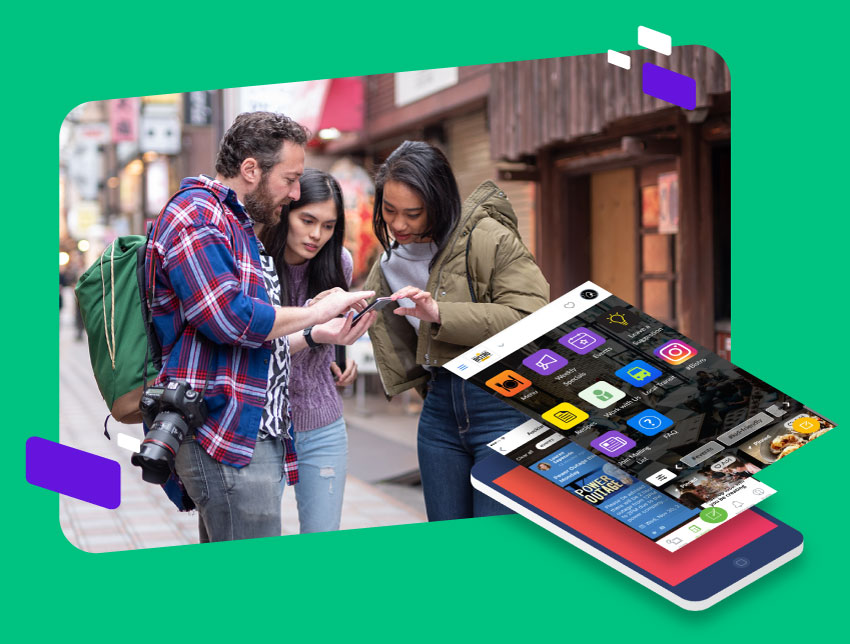Destination marketing managers are always looking for the latest trends to help them better serve their tourists. We will be discussing destination marketing trends for 2022. We have identified major trends that we believe DMOs and the travel industry should be aware of. Whether you are working with domestic travel, international travelers, you’ll benefit from this list of travel marketing trends for destinations. These trends encompass a wide range of topics, from technological advances to changes in traveler behavior. Keep reading to learn more!
Trend #01: The Rise of Augmented Reality
Augmented reality (AR) is a technology that superimposes digital information in the real world. It has been around for several years now, but it is only recently that destination marketing organizations have begun to explore its potential applications.
AR can be used for a variety of purposes, such as providing turn-by-turn directions, giving users information about nearby attractions, and even enhancing the experience of visiting a museum or gallery.
In the coming year, we expect to see more destination marketing organizations incorporating AR into their marketing campaigns.
Trend #02: Increased Focus on Sustainability
As awareness of the importance of sustainability grows, destination marketing organizations are beginning to place a greater emphasis on sustainable tourism practices.
Sustainable tourism is tourism that does not hurt the environment or local communities. Some sustainable tourism initiatives that destination marketing organizations may pursue include working with local businesses to reduce their environmental footprint, promoting public transportation options, and developing educational materials for visitors about sustainable tourism practices.
Examples of sustainable tourism are:
- Ecotourism: tourism that has a low impact on the environment and supports local communities.
- Adventure travel: tourism that takes place in natural areas and involves activities such as hiking, camping, and climbing.
- Cultural tourism: tourism that helps preserve cultural heritage and traditional arts and crafts.
As more destination marketing organizations adopt sustainable tourism practices, we expect to see a corresponding increase in the number of sustainable tourism destination options available to travelers.
Trend #03: The Growth of Mobile Booking
With the increasing popularity of smartphones, it’s no surprise that mobile booking is on the rise.
A recent study found that 43% of leisure travelers and 54% of business travelers book their travel using a mobile device. As a digital marketing solution, it is a travel trend to pay attention to.
Mobile booking is convenient for travelers because it allows them to book their travel anytime, anywhere. For destination marketing organizations, mobile booking presents an opportunity to reach out to potential visitors and make the booking process more efficient.
Trend #04: The Rise of Experiential Travel
Experiential travel is a type of tourism that focuses on providing travelers with unique and memorable experiences.
Some examples of experiential travel include
- Culinary Tours
- Art and Music Festivals
- Adventure Activities
- Cultural Immersion Programs
- Wine Tastings
- Art Classes
- Yoga Retreats
As the demand for experiential travel grows, we expect to see more destination marketing organizations incorporating this type of tourism into their offerings.
Trend #05: The Growth of Virtual Travel
Virtual travel is a type of tourism that allows travelers to experience a destination without physically being there.
Some examples of virtual travel include virtual experience reality tours, 360-degree videos, and even online travel games.
As the technology continues to develop, we expect to see more destination marketing organizations offering virtual travel experiences to their visitors.
Trend #06: Personalization
Destination marketing personalization will become increasingly important. This is the process of creating customized experiences for travelers based on their individual interests and needs. In the past, destination marketing organizations have relied heavily on demographic data to segment their audiences and create personalized messages.
However, with the proliferation of new technologies, destination marketing organizations now have access to a wealth of data that goes far beyond demographics. This data can be used to create highly personalized experiences for travelers, which will become increasingly important as destination marketing becomes more competitive.
Examples of personalization are destination marketing and tourism include:
- Tailored content can create customized content for travelers based on their interests and needs.
- Dynamic packaging is travel packages for travelers that include the specific activities, attractions, and accommodations that they are interested in.
- Personalized itineraries can create custom itineraries for travelers that are tailored to their interests and needs.
- Photobooths with Custom Borders can set up photo booths at their destination that print out photos with custom borders that include the traveler’s name, hometown, and other personal information.
Trend #07: The Rise of Video Marketing
Video is one of the most powerful destination marketing tools available. It can capture the attention of viewers and transport them to a destination in a way that no other medium can. In the coming year, we expect to see destination marketing organizations increasingly using video to market their destinations. Video marketing can be used for a variety of purposes, such as promoting a destination’s attractions, showcasing its natural beauty, or telling the stories of its residents.
Tourism marketing strategies involving video marketing include the following:
Trend #08: Increased use of Interactive Technology
Interactive technology will continue to play a major role in destination marketing. destination marketing organizations will use technology to personalize the visitor experience like interactive kiosks with photo booths taking selfies at landmarks. Interactive touch screen kiosks that can connect your downtown area will continue to grow. In fact, the interactive kiosk industry is expected to steadily grow to $45.8 Bn by 2032. In addition, destination marketing organizations will use technology to connect with their audiences through social media, email marketing, and other channels. The use of interactive technology in destination marketing will become increasingly important as destination marketing becomes more complex and competitive.
Keep up with all of the destination marketing trends by joining the HootBoard newsletter. We keep a close eye out for the next big thing for DMOs. In fact, we are experts in trend #8! If you want to learn more about how interactive kiosks can bring your destination together, then reach out to us.
Learn More About Interactive Tourism Kiosks




